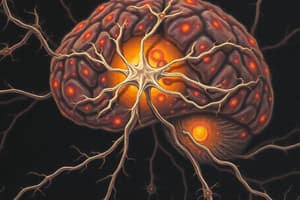Podcast
Questions and Answers
What is the main function of neurons in the nervous system?
What is the main function of neurons in the nervous system?
- Generating neurotransmitters for the body
- Producing energy for the brain
- Supporting and protecting other cells in the brain
- Processing and transmitting electrical and chemical signals (correct)
Which part of a neuron carries signals away from the cell body?
Which part of a neuron carries signals away from the cell body?
- Dendrites
- Axon (correct)
- Cell Body
- Synapse
What is the role of neurotransmitters in neuron communication?
What is the role of neurotransmitters in neuron communication?
- Generating electrical impulses in the neuron
- Initiating signal reception in other neurons
- Transmitting signals across the synapse to neighboring neurons (correct)
- Providing structural support to the neuron
Which type of neuron transmits sensory information from the body to the brain and spinal cord?
Which type of neuron transmits sensory information from the body to the brain and spinal cord?
What are the smaller cells in the nervous system that include astrocytes and microglia?
What are the smaller cells in the nervous system that include astrocytes and microglia?
Which part of a neuron contains the nucleus and other organelles?
Which part of a neuron contains the nucleus and other organelles?
Flashcards are hidden until you start studying
Study Notes
Nervous System Cells
- The nervous system consists of two main types of cells: neurons and glial cells.
- Billions of neurons are present in the nervous system.
Neurons
- Neurons are specialized cells that transmit chemical and electrical signals in the brain.
- They are the basic building blocks of the nervous system, responsible for transmitting information throughout the body.
Structure of Neurons
- A neuron consists of three main parts: cell body (soma), dendrites, and axon.
- The cell body (soma) contains the nucleus and other organelles.
- Dendrites are branch-like extensions that receive signals from other neurons.
- The axon is a long fiber that carries signals away from the cell body to other neurons or to muscles or glands.
How Neurons Communicate
- Neurons communicate through electrical impulses and chemical signals.
- When a neuron receives a signal, it generates an electrical impulse that travels down the axon.
- At the end of the axon, neurotransmitters are released into the synapse, the gap between neurons.
- Neurotransmitters bind to receptors on the dendrites of neighboring neurons, transmitting the signal.
Types of Neurons
- Sensory neurons transmit sensory information from the body to the brain and spinal cord.
- Motor neurons carry signals from the brain and spinal cord to muscles and glands.
Glial Cells
- Neuroglia are smaller than neurons.
- Examples of glial cells include astrocytes, oligodendrocytes, and microglia.
Studying That Suits You
Use AI to generate personalized quizzes and flashcards to suit your learning preferences.





